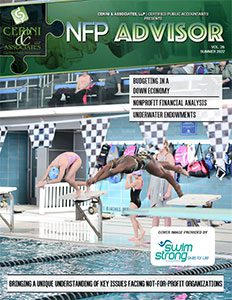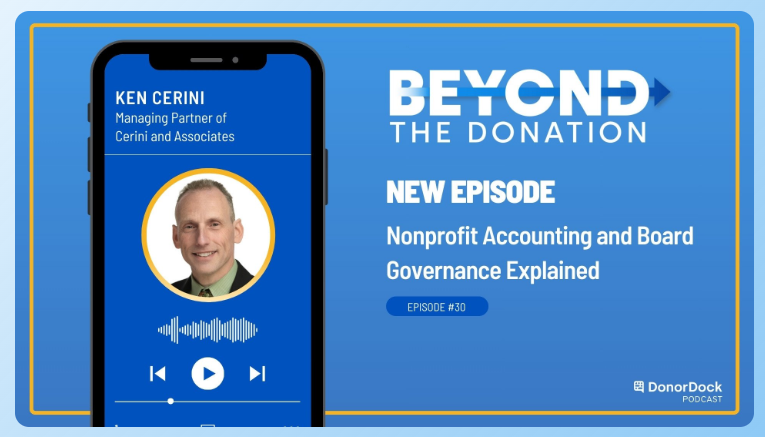If you have been following the stock market, you know that the stock market is having one of its worst years in more than 50 years. With portfolios heading down, many nonprofit organizations are seeing declines in their investments and endowments, which could open up certain concerns from both an accounting and a legal perspective.
From a legal perspective, you have the New York Prudent Management of Institutional Funds Act (“NYPMIFA”), which strives to promote a total return approach to spending, similar to that of the total return approach to investing. NYPMIFA supports investing at a rate that will preserve the purchasing power of the principal over the long-term, while spending at a rate that will reflect the donor’s intentions. NYPMIFA requires a nonprofit’s Board to develop formal spending and investment policies, and also to review those policies on an annual basis. Additionally, there are eight factors for prudent managing and investing of an institutional fund outlined by NYPMIFA. Nonprofits are required to have a written policy describing how those standards have been adopted and how they are to be implemented in managing and investing the organization’s funds. In addition, on at least an annual basis, the Board must review its investments against certain factors specified within NYPMIFA to determine if the Board is meeting the NYPMIFA-imposed duty to manage and invest the fund in good faith and with the care an ordinarily prudent person in a like position would exercise under similar circumstances. This review must be documented and must consider the following if they are relevant:
- General economic conditions
- The possible effect of inflation or deflation
- The expected tax consequences, if any, of investment decisions or strategies
- The role that each investment or course of action plays within the overall investment portfolio of the fund
- The expected total return from income and the appreciation of investments
- Other resources of the organization
- The needs of the organization and the fund to make distributions and to preserve capital
- An asset’s special relationship or special value, if any, to the purposes of the organization
Contemporaneous Board minutes should reflect a careful review of each of these 8 factors. It is not sufficient to merely state that the Board reviewed the 8 factors, but rather, the minutes should detail the substantive consideration given to each factor by the Board. If any of the factors was determined not to be relevant, the basis for that determination should be included in the minutes.
The fund must be diversified, unless the institution prudently determines that, because of special circumstances, the purposes of the fund are better served without diversification. NYPMIFA places a spotlight on a decision not to diversify by providing that an organization shall review a decision not to diversify as frequently as circumstances require, but at least annually.
With the downturn in the economy, the significant decline in investments, and the dramatic increase in inflation, changes in investment strategies may be warranted in order to remain prudent stewards of organizational investments.
From an endowment perspective, donor intent is the deciding factor on how endowment funds can be utilized. A donor can either provide that the corpus be held in perpetuity and some or all of the investment income can be used, or that a set amount of the funds be spent, regardless of the value of the corpus (this is quite common with respect to scholarship funds).
If the donor is silent as to how an endowment should be utilized, and only if the organization complies with the mandatory technical and procedural requirements of NYPMIFA, NYPMIFA provides the organization’s Board with the ability to make the decision as to how the endowment funds will be utilized – subject always to NYPMIFA’s prudence standard. The mandatory technical and procedural requirements of NYPMIFA that must be complied with include a specific form of notice to donors allowing them to opt in or out of NYPMIFA’s spending provisions if the gift instrument was executed before September 17, 2010.
With two different methodologies in place, each having a significantly different way funds can be expended, especially when an endowment is underwater (asset value is lower than the original contribution amount), it is important to ensure that endowment strategies are properly documented.
In a situation where an endowment is underwater and the fund is required to be held in perpetuity, with the preservation of the corpus of the endowment required to be maintained, none of the endowment will be able to be distributed. This could leave a hole in an organization’s budget. Conversely, where an endowment allows for part of the corpus to be spent, payments from the endowment can be made, albeit it at potentially lower levels than normal due to the decline in the balance of the endowment. The amount that can be spent will be based upon the spending policy the organization has put in place and the provisions, rules, processes and procedures within NYPMIFA (including the prudence standard).
Note that NYPMIFA contains a provision that creates a rebuttable presumption of imprudence if an organization appropriates more than a specified percentage of a fund’s fair market value. This rebuttable presumption of imprudence does not apply to appropriations permitted under law or under the gift instrument, nor does it create a presumption of prudence for a lesser appropriation for expenditure.
From an accounting perspective, any declines in the value of a permanent endowment will be reflected as a loss within the endowment balance and the related net assets with donor restrictions.
In order to expend endowed funds, the Board of Directors must decide whether they are going to “accumulate” (leave the funds in the endowment as part of the permanent endowment) or “appropriate” (designate the funds for use either immediately or in the future) such funds. Appropriated funds remain restricted until such time as they are expended.
In deciding whether to appropriate or accumulate from an endowment fund, the organization must act in good faith, with the care that an ordinarily prudent person in a like position would exercise under similar circumstances, and must consider, if relevant, the following factors:
- The duration and preservation of the endowment fund
- The purposes of the organization and the endowment fund
- General economic conditions
- The possible effect of inflation or deflation
- The expected total return from income and the appreciation of investments
- Other resources of the institution
- Where appropriate and circumstances would otherwise warrant, alternatives to expenditure of the endowment fund, giving due consideration to the effect that such alternatives may have on the institution
- The investment policy of the organization
Similarly, to its investment policy, a nonprofit organization needs careful review and documentation of its decision to appropriate or accumulate endowment funds (whether in a down economy or otherwise) to ensure that it is following NYPMIFA regulations, as an endowment, by its very nature, is meant to have a long-term benefit to the organization and those it serves. Here too, contemporaneous Board minutes should reflect a careful review of each of these 8 factors. It is not sufficient to merely state that the Board reviewed the 8 factors, but rather, the minutes should detail the substantive consideration given to each factor by the Board. If any of the factors was determined not to be relevant, the basis for that determination should be included in the minutes.
The Board of Directors has a fiduciary responsibility to ensure that its resources are being prudently invested and expended. NYPMIFA provides a statutory framework to ensure that this is being appropriately done. Organizations and their Boards should take the time to understand NYPMIFA and its impact, especially in a down market where there will be a greater level of need, and likely a greater level of scrutiny.

Kenneth R. Cerini, CPA, CFP, FABFA
Managing Partner
Ken is the Managing Partner of Cerini & Associates, LLP and is the executive responsible for the administration of our not-for-profit and educational provider practice groups. In addition to his extensive audit experience, Ken has been directly involved in providing consulting services for nonprofits and educational facilities of all sizes throughout New York State in such areas as cost reporting, financial analysis, Medicaid compliance, government audit representation, rate maximization, board training, budgeting and forecasting, and more.






